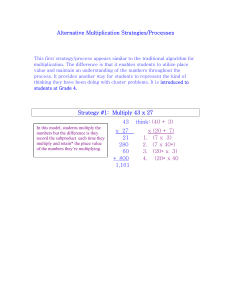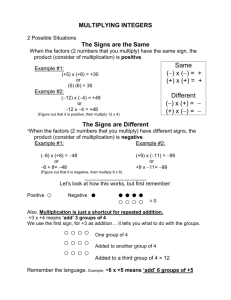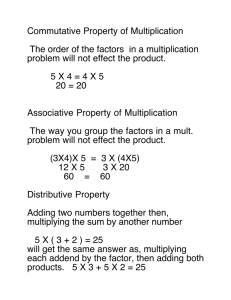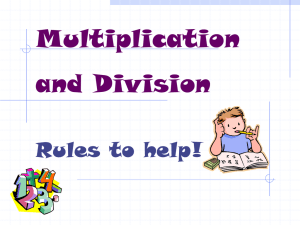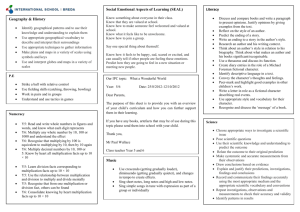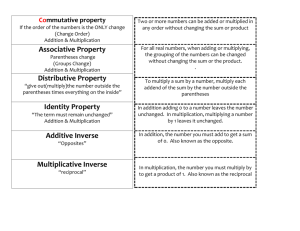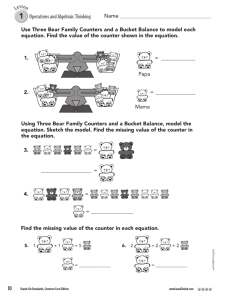Multiplying with Multiples of 10
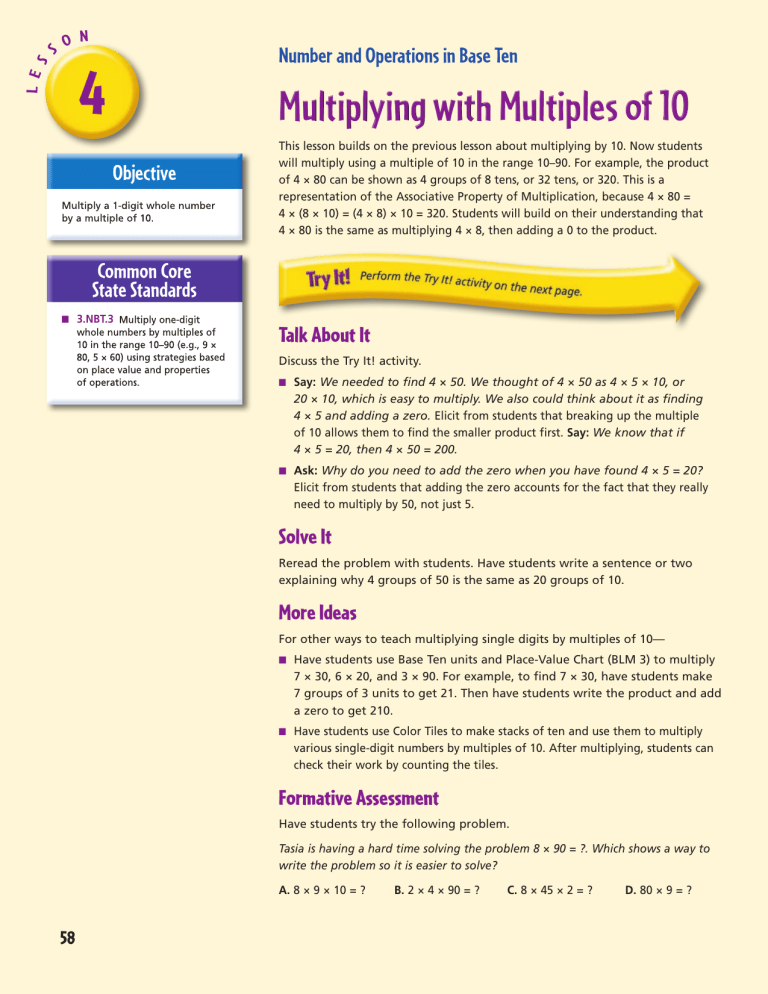
58
4
Number and Operations in Base Ten
This lesson builds on the previous lesson about multiplying by 10. Now students will multiply using a multiple of 10 in the range 10–90. For example, the product of 4 × 80 can be shown as 4 groups of 8 tens, or 32 tens, or 320. This is a representation of the Associative Property of Multiplication, because 4 × 80 =
4 × (8 × 10) = (4 × 8) × 10 = 320. Students will build on their understanding that
4 × 80 is the same as multiplying 4 × 8, then adding a 0 to the product.
■
Common Core
State Standards
Talk About It
Discuss the Try It! activity.
■
Say: We needed to find 4 × 50. We thought of 4 × 50 as 4 × 5 × 10, or
20 × 10, which is easy to multiply. We also could think about it as finding
4 × 5 and adding a zero. Elicit from students that breaking up the multiple of 10 allows them to find the smaller product first. Say: We know that if
4 × 5 = 20, then 4 × 50 = 200.
■
Ask: Why do you need to add the zero when you have found 4 × 5 = 20?
Elicit from students that adding the zero accounts for the fact that they really need to multiply by 50, not just 5.
Solve It
Reread the problem with students. Have students write a sentence or two explaining why 4 groups of 50 is the same as 20 groups of 10.
More Ideas
For other ways to teach multiplying single digits by multiples of 10—
■
Have students use Base Ten units and Place-Value Chart (BLM 3) to multiply
7 × 30, 6 × 20, and 3 × 90. For example, to find 7 × 30, have students make
7 groups of 3 units to get 21. Then have students write the product and add a zero to get 210.
■
Have students use Color Tiles to make stacks of ten and use them to multiply various single-digit numbers by multiples of 10. After multiplying, students can check their work by counting the tiles.
Formative Assessment
Have students try the following problem.
Tasia is having a hard time solving the problem 8 × 90 = ?. Which shows a way to write the problem so it is easier to solve?
A . 8 × 9 × 10 = ? B . 2 × 4 × 90 = ? C . 8 × 45 × 2 = ? D . 80 × 9 = ?
Try It!
25 minutes | Groups of 4
Here is a problem about multiplying single digits by multiples of 10.
The third and fourth grade students are going on a field trip. There are 4 buses with 50 students on each bus. How many students are going in all?
Introduce the problem. Then have students do the activity to solve the problem. Distribute Base Ten
Blocks, paper, and pencils to students.
Materials
• Base Ten Blocks (30 rods per group)
• paper (1 sheet per group)
• pencils (1 per group)
1. Elicit that 4 × 50 students are going on the trip. Write 4 × 50 on the board and have students write it on their papers. Say: Let’s model the number of students on one bus.
Ask: How can you make 50 using groups of 10?
Have students build the model using 5 rods.
Write 50 = 5 × 10 on the board and have students write it on their papers.
2. Ask: How many buses are there? How can
you model all the students on the 4 buses? Help students recognize that they can add 3 more groups of 5 rods to the model they built for one bus. Have them build the model. Ask them to count by tens, rod by rod, to determine the total number of students. Write the equation
4 × (5 × 10) = 200 on the board and have students write it on their papers.
Stress that students break the multiple of
10 into a single digit times 10. Say: When you see a multiple of ten, break that number into a single digit times 10 to make multiplication easier.
3. Have students push the rods together to form a 20 × 10 array. Elicit that 4 × (5 × 10) can be rewritten as (4 × 5) × 10, or 20 × 10. Write
(4 × 5) × 10 = 20 × 10 and 20 × 10 = 200 on the board and have students do the same on their papers.
59
Les so n
4
Number and Operations in Base Ten
Name
Answer Key
Use Base Ten Blocks to build the model. Find the product.
(Check students’ work.)
1.
3 50 = 3 × 5 × 10 = ______ 2.
4 × 30 = 4 × 3 × 10 = ______
Use Base Ten Blocks to model the product. Sketch the model.
Complete the multiplication sentence.
3.
7 20
Sketch of 7 groups of 2 rods
4.
4 40
Sketch of 4 groups of 4 rods
______ × ______ × 10 = ______ ______ × ______ × 10 = ______
Find the answer to each multiplication problem.
5.
8 × 40 = ______ 6.
9 × 20 = ______ 7.
6 × 70 = ______
8.
3 × 90 = ______ 9.
8 × 50 = ______ 10.
4 × 80 = ______
11.
9 × 60 = ______
60
Hands-On Standards, Common Core Edition
12.
7 × 40 = ______ 13.
Download student pages at hand2mind.com/hosstudent .
6 × 60 = ______
Challenge!
Marcus bought a box of cards. In the box there were 6 smaller boxes, and in each of those boxes there were 6 packs of 10 cards. To find the total number of cards he bought,
Marcus wrote this equation: 6 × 60 = 360. Is he correct? Explain how you know.
Challenge: (Sample) Yes, Marcus is correct; 6 × 60 can be written as 6 × (6 × 10), and this can be rewritten as (6 × 6) × 10, or 36 × 10, which is 360.
Download student pages at hand2mind.com/hosstudent .
Hands-On Standards, Common Core Edition
61
Les so n
4
Number and Operations in Base Ten
Name
Use Base Ten Blocks to build the model. Find the product.
1.
3 50 = 3 × 5 × 10 = ______ 2.
4 × 30 = 4 × 3 × 10 = ______
Use Base Ten Blocks to model the product. Sketch the model.
Complete the multiplication sentence.
3.
7 20 4.
4 40
______ × ______ × 10 = ______ ______ × ______ × 10 = ______
Find the answer to each multiplication problem.
5.
8 × 40 = ______ 6.
9 × 20 = ______ 7.
6 × 70 = ______
8.
3 × 90 = ______ 9.
8 × 50 = ______ 10.
4 × 80 = ______
11.
9 × 60 = ______
60
Hands-On Standards, Common Core Edition
12.
7 × 40 = ______ 13.
6 × 60 = ______ www.hand2mind.com
Name
Challenge!
Marcus bought a box of cards. In the box there were 6 smaller boxes, and in each of those boxes there were 6 packs of 10 cards. To find the total number of cards he bought,
Marcus wrote this equation: 6 × 60 = 360. Is he correct? Explain how you know.
www.hand2mind.com
Hands-On Standards, Common Core Edition
61


